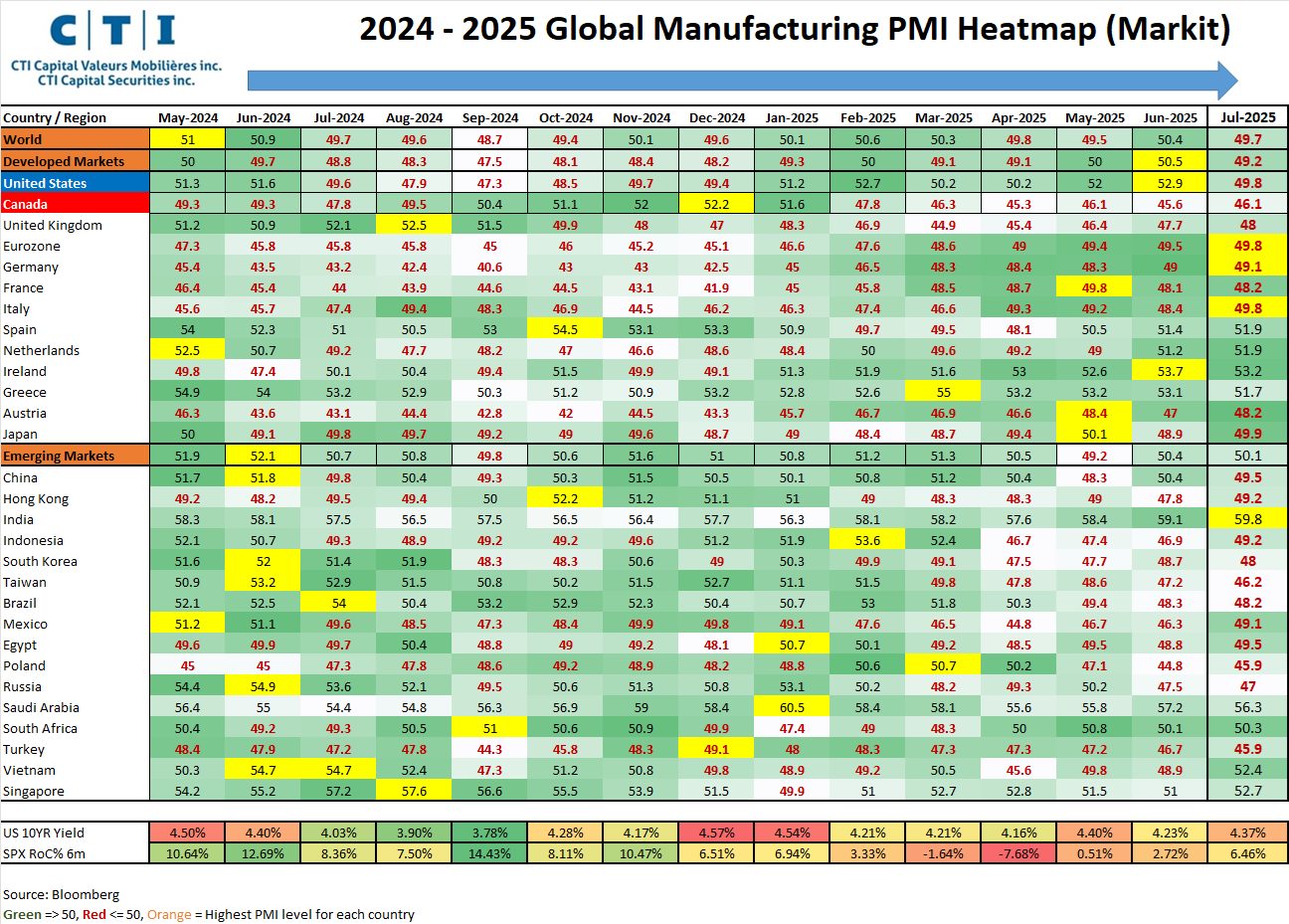Comments
26/08/2025 – Global Manufacturing PMI Heatmap (Markit)

Monthly Market Recap: July 2025
Overview
Markets gained ground in July, lifted by strong tech earnings and a steady hand from central banks. Momentum was challenged late in the month by renewed U.S.–Canada trade tensions and rising bond yields. Despite those headwinds, both U.S. and Canadian equities closed the month in positive territory.
U.S. Market Performance & Policy
U.S. indexes posted solid gains, with the S&P 500 up approximately 2.2% in USD (3.6% in CAD). The rally was driven by earnings from Microsoft, Meta, and other AI leaders. The Federal Reserve held its benchmark rate at 4.25–4.50%, though two policymakers dissented in favor of a cut. Chair Powell emphasized a data-driven approach, leaving markets speculating about possible action in September.
Key Economic Data (U.S.)
- Unemployment remained at 4.2%, while the economy added 139,000 jobs.
- Consumer spending rose 0.5%—the strongest pace in four months—led by housing, financial services, and healthcare. Inflation accelerated slightly: core PCE rose 0.3% MoM, pushing the annual core rate to 2.9%.
- Job openings declined by 176,000 to 7.18 million, and layoffs increased, reflecting cooling labor demand.
Canadian Market Update
The S&P/TSX Composite rose about 1.5% in July, closing near 27,260. Tech and energy stocks outperformed, while rising yields (10-year Government of Canada bonds rose to 3.45%) weighed on fixed income. Inflation ticked up to 1.9% in June, dampening expectations for a Bank of Canada rate cut at the July 30 meeting. Trade tensions added uncertainty as markets eyed an August 1 tariff deadline. Despite this, strong U.S. earnings helped support Canadian equities, and investor sentiment remained resilient. Consumer & Corporate Trends Microsoft and Meta earnings boosted confidence across markets. Spending strength and earnings quality offset inflation concerns, though bond market volatility signaled investor caution.
Outlook
In the U.S., solid earnings and consumer resilience support a cautiously optimistic view. In Canada, a strong TSX and stable credit conditions offer a positive backdrop, though inflation and trade remain watchpoints.
Monthly Market Recap: June 2025
Overview
Markets advanced in June, recovering from early volatility tied to renewed tariff tensions and geopolitical instability. Mid-month softness gave way to strength, as firm labor data, easing inflation, and expectations of a steady Federal Reserve helped lift sentiment into quarter-end.
U.S. Market Performance & Policy
Equities posted solid gains, with the S&P 500 surpassing 6,000 mid-month. Mega-cap tech continued to lead, while broader strength emerged in healthcare and industrials. The Federal Reserve kept rates unchanged at 4.25–4.50%, maintaining a data-driven stance. Markets began to price in a higher likelihood of a policy shift later in the year, as inflation indicators cooled and economic growth remained uneven. Key Economic Data (U.S.)
Fed Funds Rate: 4.33% (unchanged in June)
Unemployment: 4.2% (steady from May) M2 Money Supply: $22.0 trillion (rising gradually)
Consumer Confidence: Fell to 93.0
Core PCE Inflation: +0.2% month-over-month; 2.8% year-over-year
GDP (Q1 final): Contracted -0.5% annualized
Despite a negative Q1 GDP revision, household spending and labor markets remained stable, helping offset broader concerns about slowing output.
Consumer & Corporate Trends
Consumer confidence declined for a second straight month, reflecting concern over prices and geopolitical headlines. However, spending on essentials and services held firm. Corporate earnings were mixed, with strength in tech and communications. Oil prices rose amid global conflict, lifting energy stocks. Tariff tensions and weak manufacturing sentiment weighed on outlooks in export-driven sectors.
Canadian Market Update
The S&P/TSX Composite rose by approximately 2.6% in June, driven by gains in energy, healthcare, and financials. Headline inflation cooled to 1.7%, and the Bank of Canada held rates steady. Manufacturing data remained soft, and unemployment ticked up to 7.0% as exports weakened under new U.S. tariff measures. Housing remained resilient in major markets, though activity moderated. Investor attention turned to Bank of Canada guidance amid mounting pressure from slowing global trade.
Outlook
In the U.S., steady employment and cooling inflation support cautious optimism, though weak growth and softening sentiment warrant attention. In Canada, strong equity performance and central bank flexibility offer stability, but trade tensions and labor softness remain key risks.